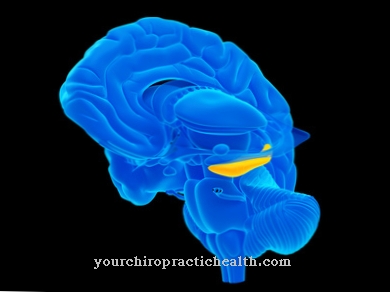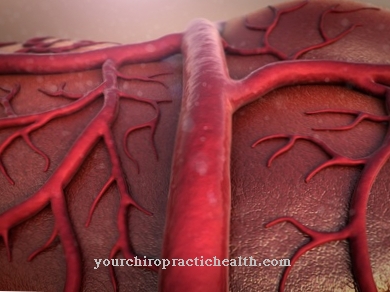In the Cementogenesis the root cement of the tooth root is created. The root cement belongs to the tooth holding apparatus and supports it in embedding the tooth in the tooth socket. Both fibroblasts and cementoblasts are involved in cementogenesis.
What is cementogenesis?

Cementogenesis describes the entire process of the formation of tooth root cement. It is part of the embryonic tooth development, which is known as odontogenesis. However, cementogenesis is not limited to embryonic tooth development. Tooth cement formation takes place throughout life as long as the dental apparatus is undamaged.
The root cement surrounds the dentin of the root and has a bone-like consistency. Together with the dentin, it enables the tooth to be firmly anchored in the tooth-holding apparatus. Dentin and root cement both consist of a network of collagen fibers and mineral components. The root cement has a larger mineral content in the form of hydroxyapatite. Its composition is similar to that of the bones.
The mineral component hydroxyapatite contains large amounts of calcium and phosphates. The root cement consists of approx. 65 percent hydroxyapatite, 23 percent an organic matrix of collagen fibrils and cementocytes and 12 percent water.
The cementoblasts are responsible for the formation of the root cement. The cementoblasts develop from the mesenchymal cells of the tooth sacs or the jaws. The tooth sacs consist of connective tissue and envelop the tooth crown before tooth eruption during tooth development.
Function & task
The goal of cementogenesis is the formation of dental cement. Tooth cement only surrounds the tooth root to firmly anchor the tooth in the tooth holding apparatus and is therefore also known as root cement. Cementogenesis only begins at a later point in tooth development. Two types of root cement are formed. There is a cellular and an acellular form.
First the acellular variant develops. At the beginning of cementogenesis, fibroblasts and cementoblasts differentiate from the embryonic mesenchymal cells. The fibroblasts produce type I collagen fibers and use them to form the so-called Sharpey fibers of the periodontal membrane. During cementogenesis, the periodontal membrane is embedded in the cementum. The cementoblasts only differentiate from the follicular cells after the hertwig epithelial sheath has dissolved. In doing so, they secrete fine collagen fibrils. These fibrils move away from the tooth at right angles. As the process progresses, more collagen is deposited to lengthen and thicken the fiber bundles.
This is followed by the further deposition of bone sialoprotein and osteocalcin. This creates a secretion matrix made of fibers and proteins. After the onset of mineralization, the cementoblasts leave the root cement. The remaining fibers on the surface connect with the periodontal ligaments of the periodontal membrane.
Only when the tooth formation is almost complete does the cellular root cement come into being. This is formed around the fiber bundles of the periodontal ligaments. However, the cementoblasts do not move away here, but are literally embedded in the root cement. These walled-in cementoblasts are then called cementocytes.
It is believed that the cementoblasts for both types of cementogenesis come from different sources.The cells for acellular cementogenesis are said to come from the dental follicle, while cementoblasts from the neighboring bones initiate cementogenesis when the cellular root cement is formed.
However, there is no cellular root cement in teeth with only one root. It is only found in premolars and molars. It is located at the root tip and between the tooth roots.
You can find your medication here
➔ Medication for toothacheIllnesses & ailments
Inflammatory processes affecting the entire periodontium also lead to a disruption of cementogenesis. As a result, the jawbone, gums, tooth roots and root cement recede. The tooth loosens and dies. Overall, this process is called periodontal disease.
Periodontitis starts from a bacterial infection of the gums or the tooth. First, the gums separate from the jawbone. As a result, other bacteria, fungi or viruses can get into the gingival pockets. It is difficult to clean the gingival pockets, so that a chronic process of disintegration of the entire tooth support system often develops.
Depending on the strength of the immune system, there is a more or less severe decline in the gums, the jawbones and the dental cement. In untreated cases, the connective tissue fibers that hold the teeth in the teeth are destroyed. At the same time, the tooth substance is also broken down by acidic breakdown products of the food until the nerves are exposed. The result is severe toothache.
As the process progresses, the nerves supplying the tooth also die. The tooth is no longer supplied and also dies. The processes of cementogenesis also come to a standstill. The protective layer of the tooth root in the form of the root cement continues to be broken down by the mechanical and chemical loads, but no new root cement is created. The already dead tooth loses its hold in the tooth holding apparatus over time, loosens and ultimately falls out.
Dental diseases can also lead to a wide variety of other complaints, which initially do not lead to the cause of sick teeth. These include rheumatic diseases as well as cardiovascular diseases.
In connection with cementoblasts, these cells can also proliferate. A benign cementoblastoma develops. This tumor is very rare and usually does not cause pain. It is associated with hypercementosis. Treatment is usually not necessary.












.jpg)



.jpg)










.jpg)
